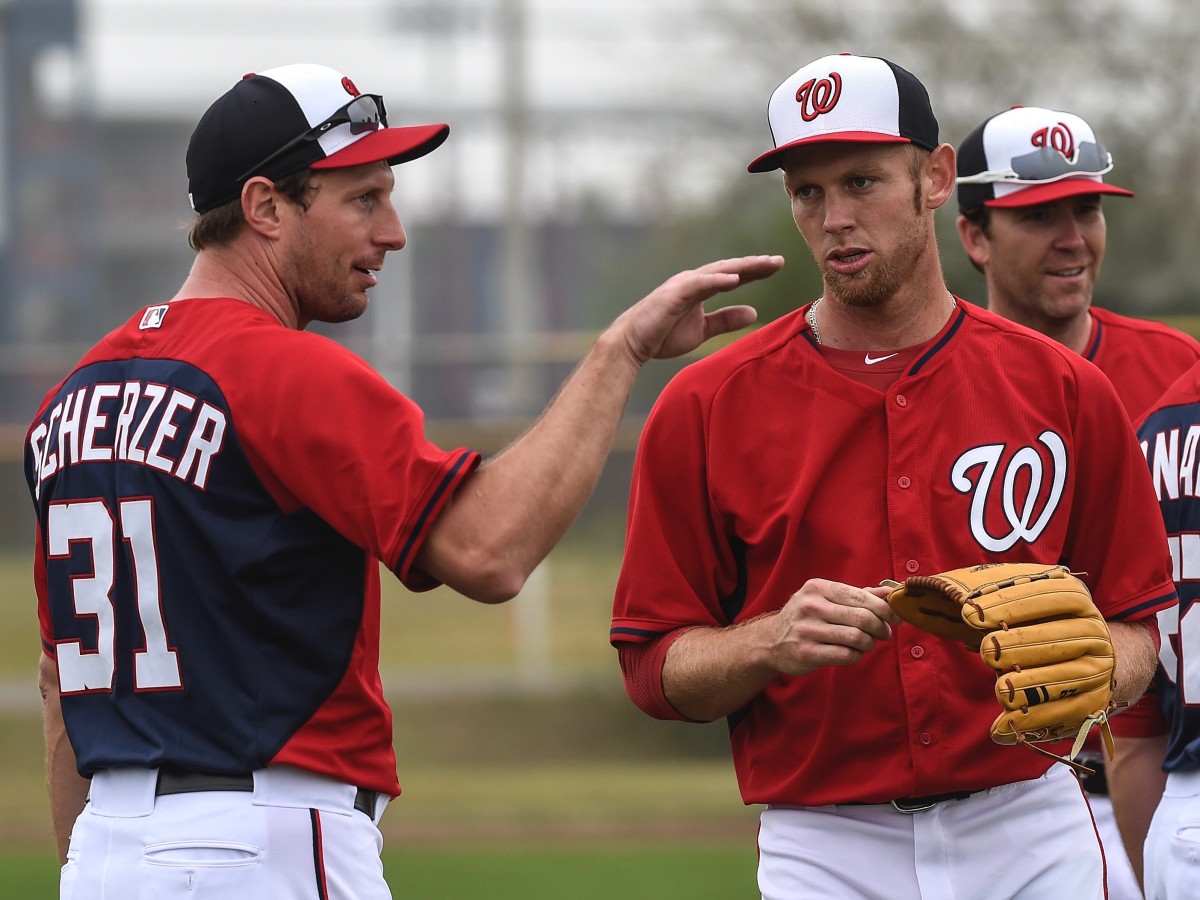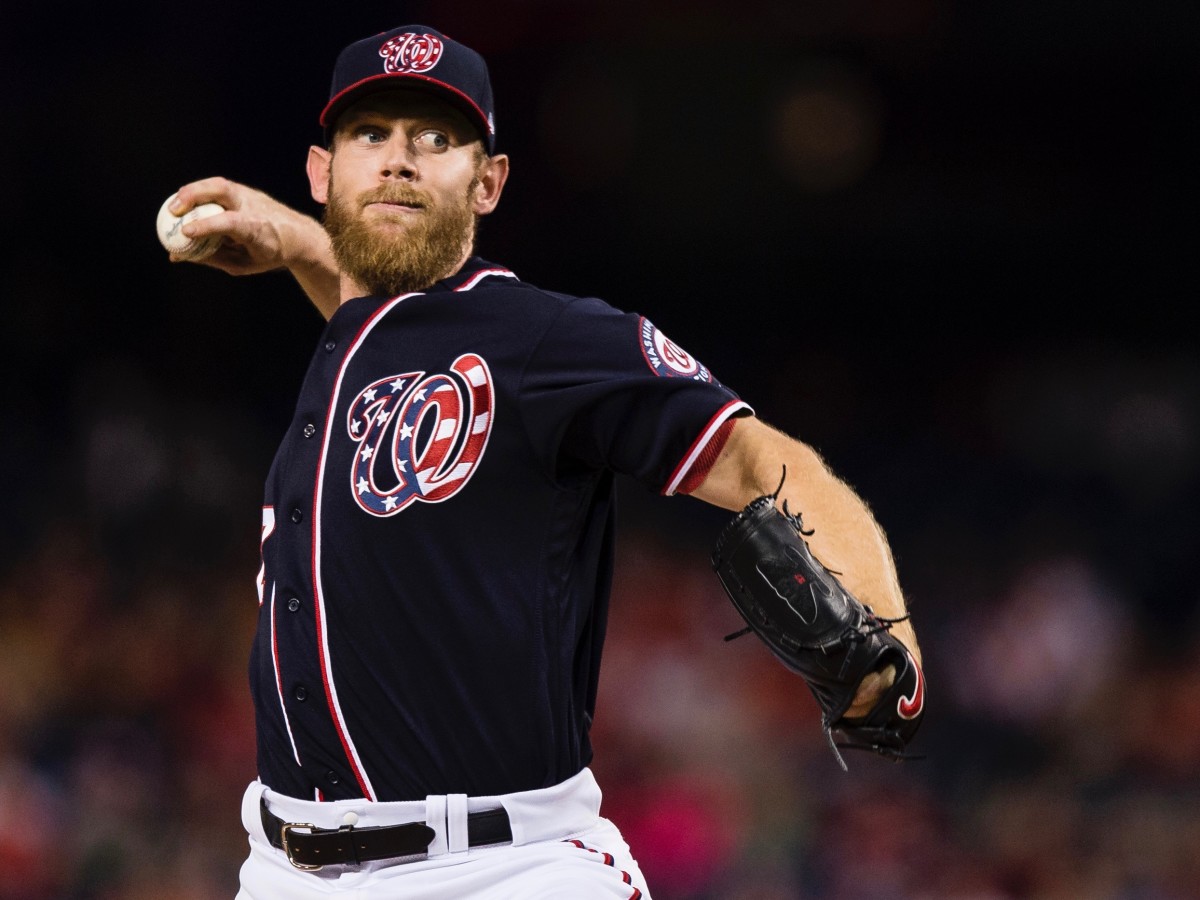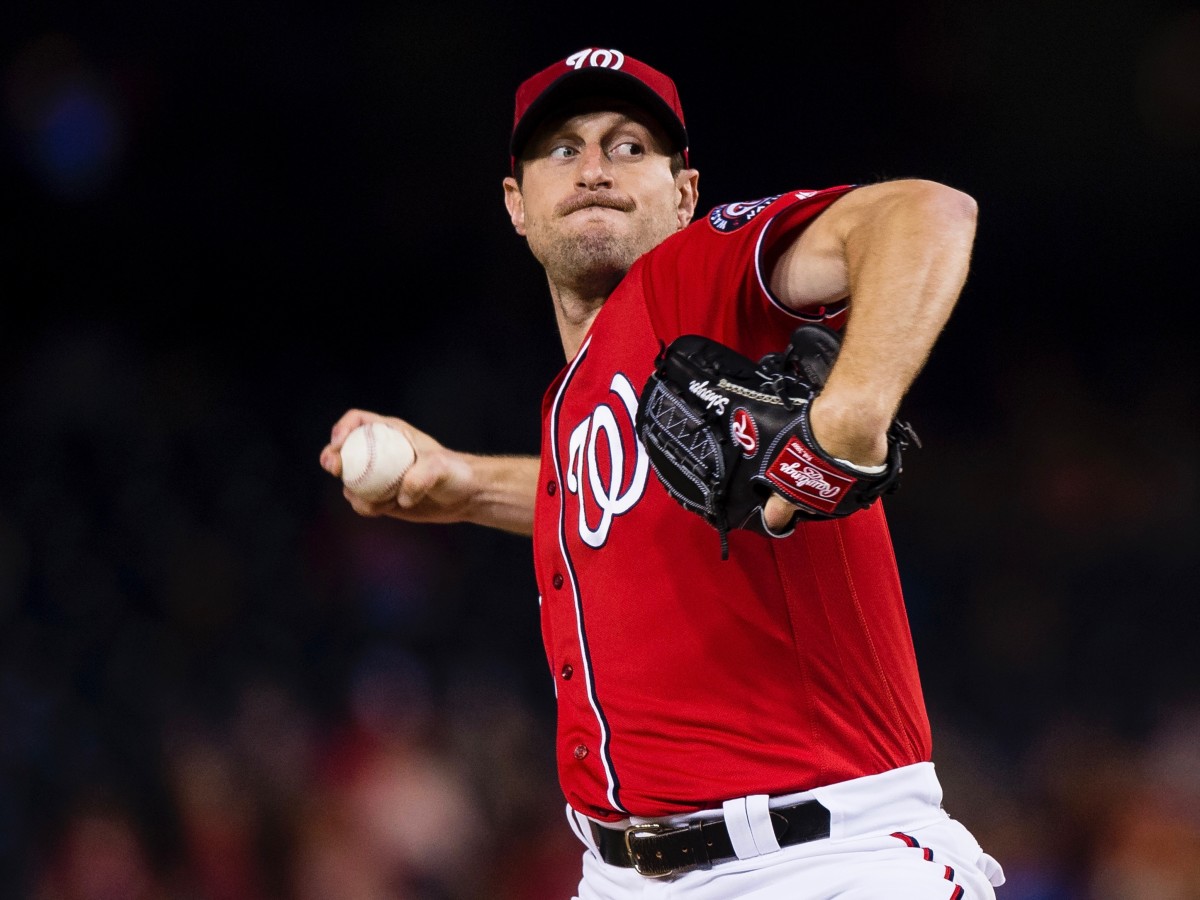How Max Scherzer's Arrival Eased the Pressure on Stephen Strasburg and the Nationals

Professional athlete is one of the few careers that requires a person to be good both at a job and at a completely unrelated skill: handling attention. You can be the best accountant in the world and still toil in obscurity, but if you are a pitcher who wants to face elite hitters, you must be able to do it with 40,000 people screaming at you and a dozen reporters clamoring to ask you probing questions afterward. Fans stop you on the street, and teammates expect you to make speeches in the clubhouse. Strangers know your salary and receive instantaneous updates about your every bump and bruise, and they have opinions about all these things. You are famous whether you want to be or not.
The Washington Nationals’ ace feeds off that attention.
And the Washington Nationals’ ace would prefer to be left alone.
Most postseason teams have at least one topline No. 1 starter. The Nationals have two. You can shuffle them and deal them in either order. Ideally, when the playoff rotation is announced, Max Scherzer would pitch Game 1 and Stephen Strasburg Game 2. A hamstring tweak in his final regular-season start means Scherzer will be pushed back a game or two—but Strasburg will slide right in, with better pure stuff than any other No. 2 starter in the postseason.
Washington has not won a playoff series since the franchise relocated from Montreal in 2005. This year’s team boasts the best young position player in the game not named Trout, rightfielder Bryce Harper; another MVP candidate, third baseman Anthony Rendon; and a deep rotation behind Scherzer and Strasburg, with lefthander Gio González at No. 3 and Tanner Roark at No. 4. But whether the Nationals succeed in October will depend on their two aces.
As they will on the mound, they follow each other across the NL pitcher leader boards: Scherzer, 33, is second in strikeouts per nine innings, with 12.0; Strasburg, 29, is fifth (10.5); Strasburg is first in fielding-independent pitching, at 2.72, Scherzer is second (2.90); Scherzer has been worth a league-best 7.2 wins above replacement, Strasburg is third (6.4).
This is the one-two punch the team envisioned when it selected Strasburg with the first pick of the 2009 draft and signed Scherzer to a seven-year, $210 million deal before the ’15 season. But the pair’s success wasn’t always a foregone conclusion.

****
Tony Vitello liked the lanky righthander almost immediately. A few hours into his official recruiting visit to Missouri, in his senior year of high school, Max cajoled the coach with the heat-averse palette into ordering the Diablo pasta at a local restaurant. “He spent the rest of the meal laughing at me because I was sweating like crazy,” says Vitello, now the head coach at Tennessee and one of Scherzer’s close friends.
Scherzer does not tread lightly in unfamiliar surroundings or with new acquaintances. The July before the pitcher signed with Washington, leftfielder Jayson Werth was clocked driving 105 mph in a 55-mph zone a few miles northeast of Nationals Park. He eventually served five days in jail the following January. Early in spring training, Scherzer’s first with the team, Werth was serenaded by his new teammate, who had written a rap about the event. “I had to,” says Scherzer through peals of laughter.
He quickly inserted himself into the team culture. He organized a March Madness pool, a rollicking auction-based contest that he generally wins.
Werth: “He thinks he’s good at math.”
Scherzer: “I am good at math. Especially compared to someone who’s been to jail.”
Scherzer counsels young players and drives coaches crazy with incessant chatter on the bench. “He’s inquisitive on every pitch, every swing, every cutoff man hit,” says pitching coach Mike Maddux. “My ears are tired! Sometimes I walk away and get a drink of water.”
Scherzer takes pride in creating an enjoyable atmosphere; the grind of the season is much more tolerable if people are having fun. Of course, fun often comes from winning, and Scherzer knows that better than most.

****
For Strasburg, atmosphere was secondary. At West Hills High School, he regularly compensated for the weak defense behind him by whiffing double-digit batters. If I have to do it all myself, I will, he decided. By his junior year at San Diego State, he was throwing 102 mph and had the Nationals—who had the first pick in the draft—salivating. He set attendance records nearly everywhere he went in the minors, and ESPN broadcast parts of his Double A debut. He was aghast when reporters began contacting his family without his permission.
Three hundred sixty-four days after he was drafted, Strasburg struck out 14 batters in his major league debut against the Pirates. Hungry writers begged him to open up, but he described his debut as “just another week.” For D.C. fans Strasmas came every five days that season—until August, when he underwent Tommy John surgery.
He came back a year later, and in spring training of 2012, GM Mike Rizzo laid out the team’s plan for Strasburg: He would pitch on a regular schedule and throw 160 innings, and then he would be done, no matter what. Strasburg spent the season alternating between tossing gems (28 starts, 197 K’s) and walking upstairs to Rizzo’s office to plead his case for more action. I’m fine, he insisted. Let me pitch.
Trevor Bauer Mastered the Indians' Modern Pitching Strategy in Game 1 Win over Yankees
The 2012 Strasburg Shutdown became the main topic of conversation for fans in D.C. Armchair GMs criticized the perennial doormat that had the temerity to believe this wouldn’t be its only shot. Pundits questioned Strasburg’s will to win. He began having trouble sleeping. In the end the media coverage became so relentless that the team shut him down a start early. “I don’t know if I’m ever going to accept it, to be honest,” he told reporters after his last outing. “You don’t grow up dreaming of playing in the big leagues to get shut down when the games start to matter.” He watched glumly from the bench as the Cardinals eliminated Washington in five games in the division series.
Between the Tommy John surgery and a series of other, more minor ailments—a strained lat muscle, a left-oblique strain, an upper-back strain, right-elbow soreness, a right-flexor-mass strain—Strasburg has only pitched one postseason game, a five-inning battle in Game 1 of the 2014 NLDS, a 3–2 loss to the Giants. His numbers are spectacular: His lifetime ERA is 3.07, and his strikeout rate—10.54—is third in history, after only Randy Johnson’s and Chris Sale’s. Yet he has never won a game that truly mattered.
In high school he would kick the dirt and throw his glove when he got frustrated. Aztecs coaches taught him to rein himself in, but then they became concerned that he’d become too cool. Today the Nats laud his poker face. But beneath that still surface lurks a mind that is churning.
“The difference between them is that Max says it,” Maddux says. “Stras thinks it.”

****
Scherzer has had plenty of time to think about the low point of his career. It was not when the Diamondbacks—the team that had drafted him with the 11th pick three years earlier—traded him to the Tigers in 2009. It was not the next May, when he was demoted to Triple A Toledo to rebuild his mechanics. And it was not even the moment, 18 months later, when manager Jim Leyland trudged to the mound to remove him from a decisive ALCS Game 6 in which he allowed six runs in 21⁄3 innings against the Rangers. The worst days of Scherzer’s career followed that outing, when he reflected on what he had become.
“I had lost the drive to get better,” he says. “I thought just being good was good enough.”
Success on the mound had not come easily for him. At the University of Missouri, Scherzer was all potential, not much polish—high-90s heat but no control over his body. His hat would fly off when his front foot landed. “It was flip a coin if he was gonna have his delivery under control enough to throw strikes,” says Vitello, “much less put it where he wanted to.”
Despite His Mortal Appearance, Jose Altuve Continues to Show He's Far From It
In the majors he relied heavily on his fastball and a solid slider, but his secondary pitches were inconsistent. Some scouts ticketed him for the bullpen. It wasn’t until late 2010 that Scherzer finally felt comfortable on the mound—too comfortable. That was the season of the ALCS flameout. He resolved never to let that happen again.
Scherzer spent that offseason poring over analytics and refining his slider. He increased his strikeout rate by nearly 50%, to better than 11 per nine, and a year later added a curveball. In 2013 he won the AL Cy Young Award.
Now Scherzer tinkers all the time. He devours Strasburg’s outings too. (“I’ll never have a curveball like his,” Scherzer says. “I just try to pay attention to the little things.”) In one of his final regular-season starts—with an eye toward the extended workload he expects in October—Scherzer asked manager Dusty Baker to leave him in the game for 110 pitches no matter how he was doing. He gave up seven runs in seven innings, but declared the outing a success.
“I’ve always said you learn more about yourself after pitch 100 than you do in the first 100,” Scherzer said after the game. “Well, this is time to learn.”
Playoff X-Factors: Which Players Will Make the Key Differences in a Quest for the World Series?
****
Scherzer hit his first career home run in August—a three-run shot against the Marlins after he pulled back a bunt—and returned to the dugout to the silent treatment. He high-fived the air, shouted a string of expletives and then yelled to the position players, “It ain’t that tough!”
Strasburg has hit three career homers, two this season. He usually declines fist bumps. “Do you even enjoy your own walk-up song?” Roark asked him. “Don’t know what it is,” Strasburg said.
Strasburg is no robot. But he generally prefers his punch lines served cold. The first time he and Scherzer played golf together, Scherzer spent much of the outing teasing Strasburg for using a neon-green ball—“a putt-putt ball,” Scherzer calls it. A few days later Scherzer opened his locker. Four dozen putt-putt balls rained down.
Scherzer’s signing could have been difficult for Strasburg. You can have more than one ace, but only one man can start Game 1 of the World Series. Yet people close to Strasburg say that he welcomed his new teammate. Scherzer’s arrival let Strasburg “share the spotlight,” says Rizzo. During his first spring training with Washington, Scherzer posed with Harper on the cover of this magazine alongside the line let’s do some damage. Reporters covering the team now flock to Scherzer.
Strasburg enjoys pressure, but he does not enjoy attention. This distinction is crucial. He is deeply private. “When I first got here, I wasn’t sure he could talk,” says Baker. Strasburg does not speak to the media the day before he starts, and if he could, he would extend that policy to cover every other day as well. He declined to comment for this story. Friends get his permission before going on the record—even to praise him. Scherzer’s presence lets Strasburg stick to what he likes to do: pitch.
Strasburg has realized, however, that while he could get away with keeping to himself as a 21-year-old phenom, he can’t as a 29-year-old veteran. Prospects have always followed him around like ducklings; these days he initiates conversations with them. He occasionally cracks a joke in a press conference. But perhaps his most significant transformation has come from understanding he doesn’t have to do it all alone.
On different days this October, an ace in Nationals red will stride to the mound under the glare of flashbulbs. He will have a long night ahead, between the game and then the frenzy of attention that comes after it. He will grip the ball and prepare to do something that comes naturally—and something else that he had to learn.
